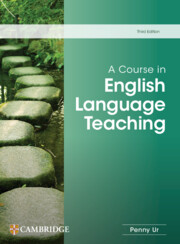Book contents
- Frontmatter
- Contents
- Acknowledgements
- Introduction
- 1 Teaching English today
- 2 The lesson
- 3 Classroom interaction
- 4 Tasks
- 5 Texts
- 6 Teaching vocabulary
- 7 Teaching grammar
- 8 Teaching listening
- 9 Teaching speaking
- 10 Teaching reading
- 11 Teaching writing
- 12 Feedback and error correction
- 13 Assessment and testing
- 14 The syllabus
- 15 Teaching/learning materials
- 16 Teaching content
- 17 Classroom discipline
- 18 Digital technology and online teaching
- 19 Learner differences 1: age
- 20 Learner differences 2: diversity and inclusion
- 21 Teacher development
- Glossary
- References
- Index
- Frontmatter
- Contents
- Acknowledgements
- Introduction
- 1 Teaching English today
- 2 The lesson
- 3 Classroom interaction
- 4 Tasks
- 5 Texts
- 6 Teaching vocabulary
- 7 Teaching grammar
- 8 Teaching listening
- 9 Teaching speaking
- 10 Teaching reading
- 11 Teaching writing
- 12 Feedback and error correction
- 13 Assessment and testing
- 14 The syllabus
- 15 Teaching/learning materials
- 16 Teaching content
- 17 Classroom discipline
- 18 Digital technology and online teaching
- 19 Learner differences 1: age
- 20 Learner differences 2: diversity and inclusion
- 21 Teacher development
- Glossary
- References
- Index
Summary
What is a syllabus?
Preliminary note: what I have here called a syllabus is sometimes called a curriculum, particularly when referring to one which has been adopted as the approved syllabus for a national education system.
A syllabus is basically a list: a document which presents information on what topics or content are to be covered, and in what order, usually in a specified course of study. With regard to English language syllabuses, it may present information on what is to be taught:
• in order to reach levels specified internationally (e.g., by the CEFR);
• in a national school system;
• in order to pass a particular examination (e.g., IELTS);
• in a specific course (no matter what materials are used);
• in a specific coursebook.
Syllabuses may be synthetic or analytic. Synthetic syllabuses provide a set of isolated language items (grammatical structures or lexical items, for example), which are then combined in the teaching process to create meaningful units that can be used in communication. Analytic syllabuses work the other way round: they describe communicative abilities, tasks or functions (how to convey simple information, for example); the particular language features are then taught as contributors to the effective performance of such components. It is common today for syllabuses to do both: see the multi-strand syllabus described on page 197. This is particularly noticeable in modern coursebooks, but also seen in those with a wider application. The syllabus for English in schools published by the Ministry of Education in Israel, for example, is laid out as a series of ‘can-dos’ relating to communicative abilities and aligned with the CEFR (see Section 3), but includes also a grammatical syllabus and a list of lexical items divided into bands for the different levels.
Basic features of a syllabus
It has clear objectives, usually explained in an introduction. These objectives are then used as the basis for selecting and ordering the components.
It is comprehensive. The actual components of the list may be, in a synthetic syllabus, content items (words, grammatical features, topics), or in an analytic one, process ones (tasks) or communicative ‘can-dos’ (standards). In any case, the syllabus attempts to be comprehensive and cover as wide a range of the target items as possible.
- Type
- Chapter
- Information
- A Course in English Language Teaching , pp. 195 - 203Publisher: Cambridge University PressPrint publication year: 2024

